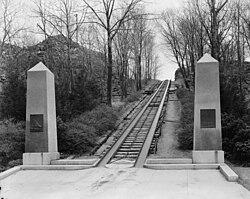
Quincy is a city in Norfolk County, Massachusetts, United States. It is the largest city in the county. Quincy is part of the Greater Boston area as one of Boston's immediate southern suburbs. Its population in 2020 was 101,636, making it the seventh-largest city in the state. Known as the "City of Presidents", Quincy is the birthplace of two U.S. presidents—John Adams and his son John Quincy Adams—as well as John Hancock, the first signer of the Declaration of Independence and the first and third governor of Massachusetts.

Milton is a town in Norfolk County, Massachusetts, United States, and a suburb of Boston. The population was 28,630 at the 2020 census.
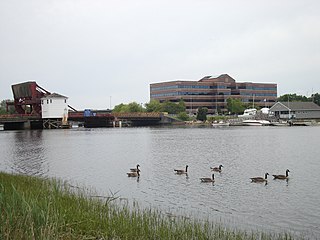
The Neponset River is a river in eastern Massachusetts in the United States. Its headwaters are at the Neponset Reservoir in Foxborough, near Gillette Stadium. From there, the Neponset meanders generally northeast for about 29 miles (47 km) to its mouth at Dorchester Bay between Quincy and the Dorchester section of Boston, near the painted gas tank.

The Bunker Hill Monument is a monument erected at the site of the Battle of Bunker Hill in Boston, Massachusetts, which was among the first major battles between the United Colonies and the British Empire in the American Revolutionary War. The 221-foot granite obelisk was erected between 1825 and 1843 in Charlestown, Massachusetts, with granite from nearby Quincy conveyed to the site via the purpose-built Granite Railway, followed by a trip by barge. There are 294 steps to the top.
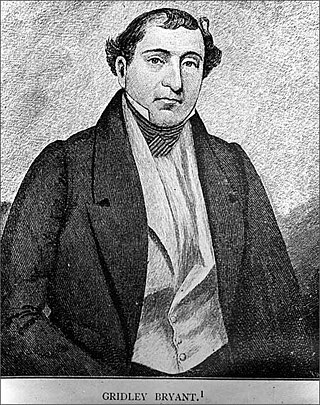
Gridley Bryant was an American construction engineer who ended up building the first commercial railroad in the United States and inventing most of the basic technologies involved in it. His son, Gridley James Fox Bryant, was a famous 19th-century architect and builder.

The Mount Lowe Railway was the third in a series of scenic mountain railroads in the United States created as a tourist attraction on Echo Mountain and Mount Lowe, north of Los Angeles, California. The railway, originally incorporated by Thaddeus S. C. Lowe as the Pasadena and Mt. Wilson Railroad Co., existed from 1893 until its official abandonment in 1938, and was the only scenic mountain, electric traction railroad ever built in the United States. Lowe's partner and engineer was David J. Macpherson, a civil engineer graduate of Cornell University. The Mount Lowe Railway was a fulfillment of 19th century Pasadenans' desire to have a scenic mountain railroad to the crest of the San Gabriel Mountains.

This is a list of the earliest railroads in North America, including various railroad-like precursors to the general modern form of a company or government agency operating locomotive-drawn trains on metal tracks.

Solomon Willard was a carver and builder in Massachusetts who is remembered primarily for designing and overseeing the Bunker Hill Monument, the first monumental obelisk erected in the United States.
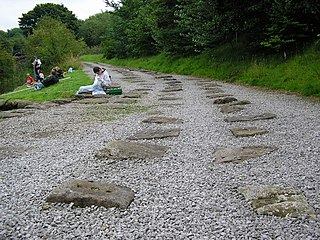
The Peak Forest Tramway was an early horse- and gravity-powered industrial railway system in Derbyshire, England. Opened for trade on 31 August 1796, it remained in operation until the 1920s. Much of the route and the structures associated with the line remain. The western section of the line is now the route of the Peak Forest Tramway Trail.

Canton Viaduct is a blind arcade cavity wall in Canton, Massachusetts, built in 1834–35 for the Boston and Providence Railroad.

A predecessor to the Class I Delaware and Hudson Railway, the 1820s-built Delaware and Hudson Canal Company Gravity Railroad('D&H Gravity Railroad') was a historic gravity railroad incorporated and chartered in 1826 with land grant rights in the US state of Pennsylvania as a humble subsidiary of the Delaware and Hudson Canal and it proved to contain the first trackage of the later organized Delaware and Hudson Railroad. It began as the second long U.S. gravity railroad built initially to haul coal to canal boats, was the second railway chartered in the United States after the Mohawk and Hudson Rail Road before even, the Baltimore and Ohio. As a long gravity railway, only the Summit Hill and Mauch Chunk Railroad pre-dated its beginning of operations.
The Leiper Railroad was a 'family business–built' horse drawn railroad of 0.75 miles (1.21 km), constructed in 1810 after the quarry owner, Thomas Leiper, failed to obtain a charter with legal rights-of-way to instead build his desired canal along Crum Creek. The quarry man's 'make-do' railroad was the continent's first chartered railway, first operational non-temporary railway, first well-documented railroad, and first constructed railroad also meant to be permanent.
The credit of constructing the first permanent tramway in America may therefore be rightly given to Thomas Leiper. He was the owner of a fine quarry not far from Philadelphia, and was much concerned to find an easy mode of carrying stone to tide-water. That a railway would accomplish this end he seem to have had no doubt. To test the matter, and at the same time afford a public exhibition of the merits of tramways, he built a temporary track in the yard of the Bull's Head Tavern in Philadelphia. The tramway was some sixty feet long, had a grade of one inch and a half to the yard, and up it, to the amazement of the spectators, one horse used to draw a four-wheeled wagon loaded with a weight of ten thousand pounds. This was the summer of 1809. Before autumn laborers were at work building a railway from the quarry to the nearest landing, a distance of three quarters of a mile. In the spring of 1810 the road began to be used and continued in using during eighteen years.
by John Bach McMaster, page 494, A History of the People of the United States, from the Revolution to the Civil War
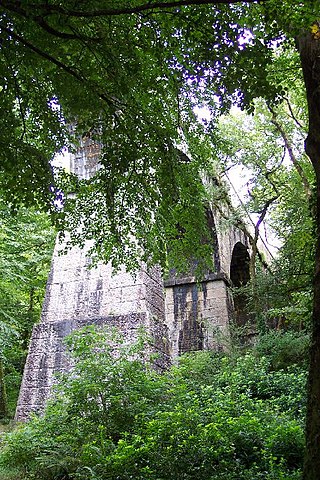
The Treffry Viaduct is a historic dual-purpose railway viaduct and aqueduct located close to the village of Luxulyan, Cornwall in the United Kingdom. The viaduct crosses the Luxulyan Valley and is part of the Treffry Tramways. It forms an integral part of the Cornwall and West Devon Mining Landscape, a World Heritage Site. It is scheduled under the Ancient Monuments and Archaeological Areas Act 1979 and due to its poor condition is on Historic England's, Heritage at Risk Register.

The Quincy Quarries is a 22-acre (8.9 ha) public recreation area in Quincy, Massachusetts, commemorating the site of the Granite Railway—often credited as being the first railroad in the United States. The former quarries produced granite for over a century, leaving problematic excavations that ultimately were taken over and filled in to protect public safety. The reservation is owned and operated by the Massachusetts Department of Conservation and Recreation.

Paul's Bridge is a stone bridge carrying the Neponset Valley Parkway over the Neponset River between Milton and southern Boston, Massachusetts. It was built in 1849 by Thomas Hollis, Jr., of Milton, but was later reconstructed using the original materials. It replaced the earlier Hubbard's Bridge, and a subsequent Paul's Bridge. Its current span is approximately 88 feet (27 m). The name "Paul" can be attributed to Samuel Paul, the owner of the adjacent land on the Readville side, which was part of Dedham at the time of the bridge's construction.
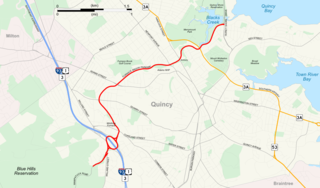
Furnace Brook Parkway is a historic parkway in Quincy, Massachusetts. Part of the Metropolitan Park System of Greater Boston, it serves as a connector between the Blue Hills Reservation and Quincy Shore Reservation at Quincy Bay. First conceived in the late nineteenth century, the state parkway is owned and maintained by the Massachusetts Department of Conservation and Recreation (DCR) and travels through land formerly owned by the families of John Adams and John Quincy Adams, passing several historic sites. It ends in the Merrymount neighborhood, where Quincy was first settled by Europeans in 1625 by Captain Richard Wollaston. The road was started in 1904, completed in 1916 and added to the National Register of Historic Places (NRHP) in 2004.

The Railway Village Historic District is a historic district encompassing a densely populated, predominantly residential, area of eastern Milton, Massachusetts. The 30-acre (12 ha) district lies roughly between East Milton Square and the town line with neighboring Quincy. The area's significant growth occurred after the 1826 construction of the Granite Railway, which transported stone from the nearby granite quarries to the Neponset River. This resulted in the movement to the area of stone workers and related interests. The principal thoroughfare of the district is Adams Street; the district extends along Pierce Street, Granite Place, and Washington Street, and includes properties on intervening and connecting streets.

The Captain Nathan Hale Monument is a 45-foot (14 m) obelisk in Coventry, Connecticut, built in 1846 in honor of Nathan Hale, the Revolutionary War hero, who was born in Coventry. It was one of the first war memorials to be built in the United States, and is a significant work of both architect Henry Austin and builder Solomon Willard. Now owned and maintained by the state, it was listed on the National Register of Historic Places in 2002.

The Dorchester and Milton Branch Railroad was a railroad in Massachusetts. It ran between Neponset Village in Dorchester, Massachusetts, through the town of Milton to the village of Mattapan. It was opened in 1847 and became part of the Old Colony Railroad system in 1848. The western portion was converted to a streetcar line in 1929, while the eastern portion remained in use for freight until the 1980s.

The Hardwick and Woodbury Railroad was a short-line railroad serving the towns of Hardwick and Woodbury, Vermont. Built to serve the local granite industry by bringing rough stone from the quarries to the cutting-houses, the railroad was about 7 miles (11 km) long, plus leased track, extended to about 11 miles (18 km) at its greatest extent. It connected with only one other railroad, the St. Johnsbury & Lake Champlain, in Hardwick.

